New Zealand Wildlife
Want to see New Zealand wildlife on your next vacation? New Zealand is filled with unique animals—although they are not always easy to spot! From the fascinating kiwi bird to the world’s smallest penguins, New Zealand is home to many species of animals. Most of the species are not native to New Zealand; the only native mammals are bats and marine mammals.
See if you can spot this unique wildlife in New Zealand:
Kiwi
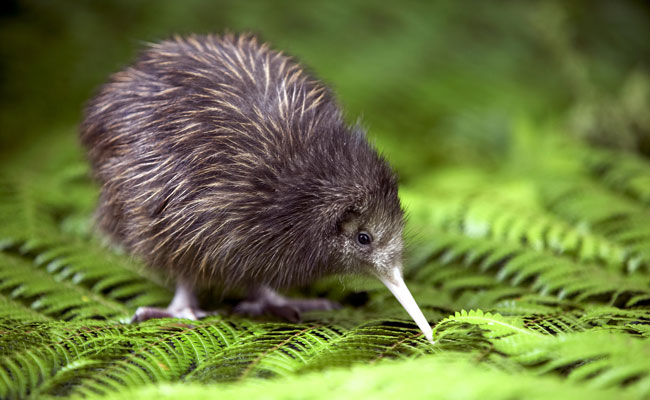
Kiwi’s are a beloved icon in New Zealand. Image: Rotorua Tourism
The Kiwi bird is so iconic that New Zealanders are known as Kiwis. These cute, fluffy birds are only found in New Zealand. They’re quite shy and only come out at night, so it’s rare to spot them in the wild.
Kiwi Fun Facts:
- Kiwi birds are nocturnal
- Kiwi eggs take up 20% of their body miss
- Kiwi birds are among the few species that mate for life; a kiwi relationship has been known to last for over 20 years
- Kiwi birds have nostrils at the end of their beaks and have a great sense of smell, unlike most birds
- Kiwi birds cannot fly and their feathers are more hair-like in texture
Where to See Them:
It’s difficult to see Kiwi birds in the wild, but you can see them at a New Zealand wildlife sanctuary. We recommend the Kiwi Birdlife Park in Queenstown or Rainbow Springs Nature Park in Rotorua.
Sheep
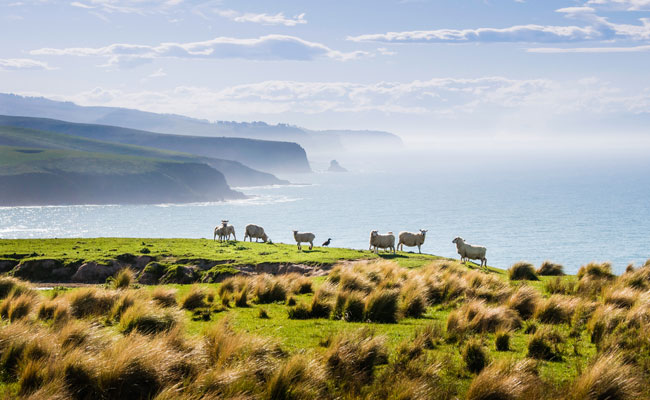
Sheep grazing in the beautiful seaside meadows of New Zealand. Image: Annandale
Sheep are not technically “wildlife,” but there sure are a lot of them—in New Zealand, there are about 10 sheep for every person! You’ll be sure to see plenty of them as you drive through lush, rolling farmland on the North and South Islands.
New Zealand Sheep Fun Facts:
- New Zealand’s first sheep were set ashore by Captain Cook in 1773
- Sheep have a field vision of around 300 degrees, which means they can see behind themselves without having to turn their head!
- Sheep are raised for four main products: lamb, mutton, wool, and milk
- The first shipment of frozen lamb and mutton sailed to London from Port Chalmers, New Zealand on The Dunedin in 1882
Where to See Them:
As we mentioned above, you’ll certainly see plenty of sheep as you’re driving from one place to the next. But if you really love sheep and want an authentic New Zealand experience, you can stay at a working sheep farm like Annandale on the South Island (complete with luxurious villa accommodations). Or take the kids to the Agrodome in Rotorua to see live sheep herding and shearing demonstrations.
Yellow-Eyed Penguin
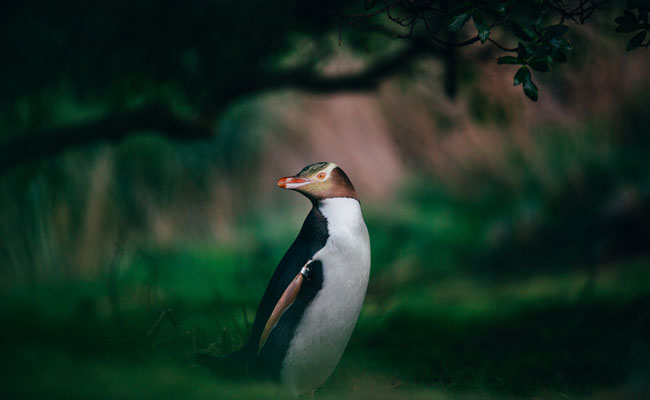
Seeing the yellow-eyed penguin is a must for birders. Image: Tourism New Zealand
Yellow-eyed penguins are among the largest penguins in the world, with adults reaching up to 2.5 feet tall, and can be found on the coasts of New Zealand.
Yellow-Eyed Penguin Fun Facts:
- Yellow-eyed penguins lay two eggs and parents typically raise both chicks
- As their name implies, yellow-eyed penguins have pale yellow eyes and their head features a bright yellow stripe extending from their eyes around the back of their head
- Yellow-eyed penguins usually nest in forests and scrub that line the New Zealand coast
- The yellow-eyed penguin is now the rarest penguin in the world due to deforestation and predators
Where to See Them:
Yellow-eyed penguins can be found on the Otago Peninsula, including the city of Dunedin. You may be lucky enough to see them waddling along the beaches on your own, but we recommend taking a wildlife tour from Dunedin if you really want to see the penguins!
Dusky Dolphin
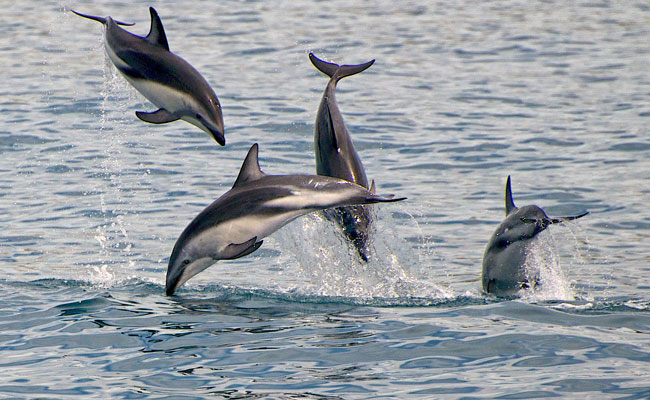
Dusky dolphins are often found among other species of whales and dolphins. Image: Encounter Kaikoura
Most people don’t think of dolphins when they think of New Zealand wildlife, but there are plenty along the coasts of this small island country. Dusky dolphins are super acrobatic and can be seen leaping out of the water and tumbling in the air. They’re very social and speedy swimmers. Clicks, squeaks, and whistles can be heard almost 2 miles away when they communicate out of the water.
Dusky Dolphin Fun Facts:
- Dusky dolphins can grow up to 7 feet in length
- The dorsal side of the dusky dolphin is dark grey with two cream lines between the fin and tail
- Dusky dolphins normally swim in pods of 10 to 20 animals
- Dusky dolphins swim close to the coast, which means a high probability of viewing them in their natural habitat
Where to See Them:
You can go swimming with dusky dolphins on a tour from Kaikoura. Be sure to do your research and choose an ethical tour operator! We have a great partner in Kaikoura that ensures a fun experience for both humans and animals.
Royal Albatross
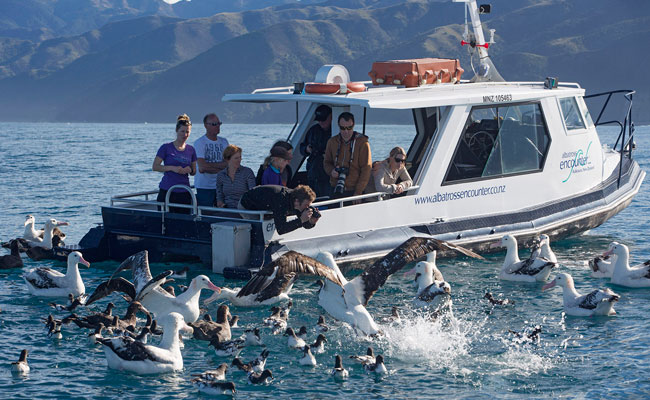
Albatrosses can live up 40 years in the wild. Image: Encounter Kaikoura
Did you know that albatross spend most of their life at sea, sometimes flying up to an estimated 118,060 miles per year? They have a huge wingspan, some reaching up to 10 ten feet across! They only spend time on land when they return to breed and raise their young. Albatross are also one of the few species that mate for life.
Royal Albatross Fun Facts:
- They can live to be 60 years old
- They have the largest wingspan of any living bird
- They have a surprisingly good sense of smell, but not as strong as a Kiwi
Where to See Them:
There’s only one place in the world where royal albatross breed on the mainland, and it just so happens to be about 20 minutes’ drive from Dunedin!
Little Blue Penguin
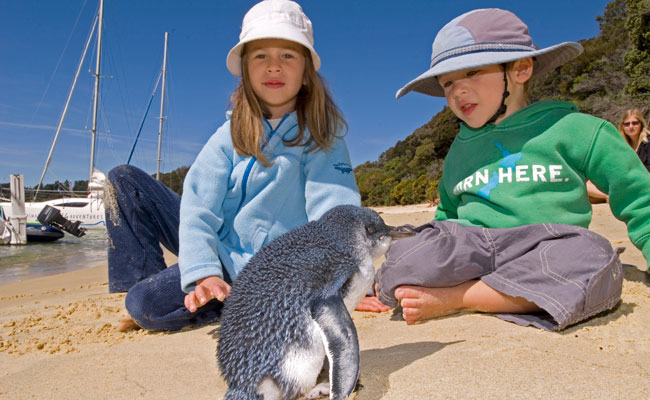
Get up close with extremely cute wild little blue penguins. Image: Tourism New Zealand
Little blue penguins are the smallest penguins in the world at just 13-17 inches tall. They usually nest in burrows, rock crevices, caves, or even under buildings. They only come ashore at dusk, which makes them easy to spot along the shore.
Little Penguin Fun Facts:
- Blue penguins weigh between 2-2.5 lbs
- Their average lifespan is 6.5 years, but there are some records of them living up to 20
- Little penguins are often in long-term relationships
- Chicks will often times return to within a few miles of where they were raised, and once they settle in that area they never move away
Where to See Them:
Like many of the other unique birds on this list, little blue penguins can be seen on a wildlife tour from Dunedin. There’s also a quirky little town called Oamaru, about 1.5 hours from Dunedin, that’s famous for its little blue penguin colony.
Ready to begin planning your own vacation to see New Zealand’s wonderful wildlife? Browse our New Zealand travel packages, or give us a call at 888-229-0082 to start planning the adventure of a lifetime!